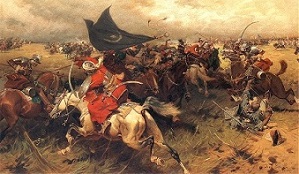
Meanwhile, Charles V’s unruly troops sacked Rome and imprisoned Pope Clement VII for six months.
This was the same Pope that refused to annul the marriage of Henry VIII and Charles V’s aunt Catherine of Aragon, leading Henry break away from Rome and start the Church of England.
(Catherine had been married for six months to Henry’s older brother Arthur before he died in 1502.)

Charles V oversaw the Spanish colonization of the Americas, and began the Counter-Reformation.

He eventually responded to the pleadings of the priest Bartolome’ de Las Casasand outlawed the enslavement of native Americans.

Gold from the New World was used by Spain to push back the Muslim Ottoman Empire’s invasion of Europe.

Sultan Suleiman the Magnificent’sOttoman fleet dominated the Mediterranean Sea, the Red Sea and the Persian Gulf.

Suleiman conquered into Christian Hungary, Christian Serbia, and Christian Austria, in addition to controlling the Middle East and North Africa.

In 1529, 35-year-old Suleiman the Magnificent sent 100,000 Muslim Turks to surround Vienna, Austria.

Martin Lutherwrote:
“The Turk is the rod of the wrath of the Lord our God …
If the Turk’s god, the devil, is not beaten first, there is reason to fear that the Turk will not be so easy to beat … Christian weapons and power must do it …”

Luther continued:
“(The fight against the Turks) must begin with repentance, and we must reform our lives, or we shall fight in vain.
(The Church should) drive men to repentance by showing our great and numberless sins and our ingratitude, by which we have earned God’s wrath and disfavor, so that He justly gives us into the hands of the devil and the Turk.”

In an attempt to unite the Holy Roman Empire against the Ottoman Muslims,Charles V agreed to a truce recognizing the Protestants, as Eric W. Gritisch wrote in Martin-God’s Court Jester: Luther in Retrospect(Philadelphia: Fortress, 1983, p. 69-70):
“Afraid of losing the much-needed support of the German princes for the struggle against the Turkish threat from the south, Emperor Charles V agreed to a truce between Protestant and Catholic territories in Nuremberg in 1532 …
Thus the Lutheran movement was, for the first time, officially tolerated and could enjoy a place in the political sun of the Holy Roman Empire.”

As the Islamic threat intensified, reformer John Calvin wrote to Philip Melanthon in 1543, (Selected Works of John Calvin: Tracts & Letters, I: 373):
“I hear of the sad condition of your Germany! … The Turk again prepares to wage war with a larger force.
Who will stand up to oppose his marching throughout the length and breadth of the land, at his mere will and pleasure?”

Get the DVD Islamic Conquest-Past & Present

Followers of the reformers who “protested” certain doctrines, were generally referred to as “Protestants.”
Some Protestant countries refused to help Charles V who was defending Europe from the Muslim invasion.

Finally, Charles V made a treaty with the German Lutheran Princes by signing the Peace of Augsburg, September 25, 1555, ceasing the religious struggle between Lutherans and Catholics.
A line in the treaty, “cuius regio, eius religio,” allowed each king to decide what was to be believed in his kingdom.

A month later, October 25, 1555, suffering from severe gout, Charles V abdicated his throne and lived the rest of his life secluded in the monastery of Yuste, leaving his son Philip II to rule, for whom the Philippine Islands were named.

As different kings in Europe chose different denominations for their kingdoms, millions migrated from one country to another simply for conscience sake.
Many of these Christian religious refugees fled Europe to settle colonies in America.
New York University Professor Emeritus Patricia Bonomi, in her article “The Middle Colonies as the Birthplace of American Religious Pluralism” wrote:
“The colonists were about 98 percent Protestant.”

Of the 56 signers of the Declaration, most were Protestant, with the notable exception of Catholic Charles Carroll of Maryland.

British Statesman Edmund Burkeaddressed Parliament, 1775:
“All Protestantism … is a sort of dissent. But the religion most prevalent in our Northern Colonies is a refinement on the principle of resistance; it is the dissidence of dissent, and the protestantism of the Protestant religion.”

Samuel Adams stated when he signed the Declaration of Independence:
“This day, I trust, the reign of political protestantism will commence.”
John Adamswrote in A Dissertation on the Canon and Feudal Law,1765:
“Desire of dominion … becomes an encroaching, grasping, restless, and ungovernable power … Tyranny, cruelty, and lust … was soon adopted by almost all the princes of Europe …
The people were held in ignorance … till God in his benign providence raised up the champions who began and conducted the Reformation.
From the time of the Reformation to the first settlement of America, knowledge gradually spread in Europe, but especially in England; and in proportion as that increased and spread among the people … tyranny … lost … strength.”